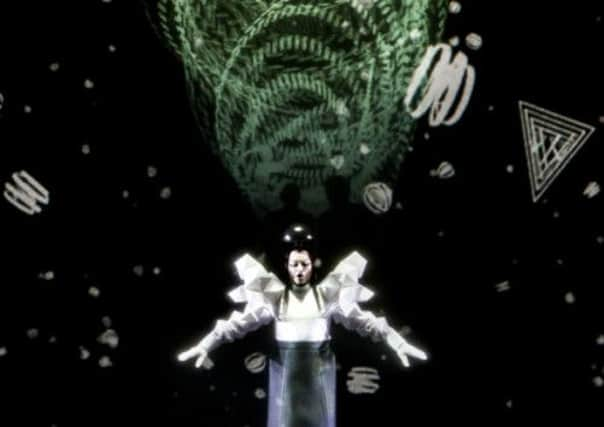EIF: Fidelio moves with the times... on Segways


Opéra de Lyon’s radical production of Beethoven’s Fidelio opens at the Edinburgh Festival Theatre next Saturday. It will either thrill or shock you.
You will absolutely love it or completely loathe it. But whichever extreme you swing to, it will challenge your belief in what opera means to us in the 21st century.
Advertisement
Hide AdFor there’s no middle ground in American director Gary Hill’s multi-layered, multi-media provocation. He is a contemporary media artist who has hardly ever seen an opera, never mind directed one. He cares little for the museum mentality that keeps opera in a stylised straightjacket. Indeed, his video projections create a mind-boggling extra dimension that plays tricks on the eyes, and plays havoc with the traditional operatic mindset.
This Fidelio is of another planet, another universe – quite literally, as the characters, dressed in Blake’s 7-style conformity and whizzing around stage on Segways in their doomed spacecraft, are finally cast into infinite space.
Whatever happened to the determined Leonora and her heroic attempts to free the imprisoned Florestan, or the noble human justice that triumphs in the closing scenes; or the plain historical references that modern productions often struggle to free themselves from? They’re there, but submerged in a mind-bending abstraction that views Jean-Nicolas Bouilly’s story as a starting point.
When I spoke to Hill about that at the time of his Lyon production premiere a few months ago, he admitted that “people could come here and think they’ve come to the wrong opera”.
“I suppose it’s a kind of mash-up,” he says, referring not just to the virtual world of his own video trickery, but to the fact he has grafted on an additional layer of text – Harry Martinson’s 1950s science fiction poem Aniara – to the earthly human libretto that Beethoven composed to.
When the opera comes to Edinburgh next week, everyone will make their own decision as to the value of Hill’s curve-ball approach. But either way, what is so interesting about this Fidelio is not so much the success or non-success of the production, but the fact that Opéra de Lyon could have taken such a risk in its home season, achieving the mature level of challenging engagement I witnessed in the French city’s dazzlingly refashioned opera house.
Advertisement
Hide AdIn charge of the company is its reputable director general Serge Dorny, who took over in Lyon ten years ago, having previously been in charge of the London Philharmonic Orchestra. He explains to me, in a bright modern office that enjoys generous views across the Lyon skyline, that this Fidelio is not something he would have chosen for his company’s main subscription season which, in 2013-14 alone, will consist of nine full-scale productions, plus a mini festival of three Benjamin Britten operas.
Instead, it formed part of a mini-festival this past season, in March and April, that looked at the theme of justice and injustice through the challenging operatic eyes of Dallapiccola, Schoenberg and, yes, Beethoven. “Had I been looking for a Fidelio production for the main season, it would have to have been something that could enter the repertoire. But in the context of a festival, you can try out things, and not reproduce what happens every day,” Dorny explains. “It is important for that purpose to create something truly exceptional, something that might create new trends, might spark a debate, something that people will question. ”
Advertisement
Hide AdDoes Dorny, himself, warm to Hill’s extreme solution to an abstract, problematic opera? “It’s a good production,” he says. “But that doesn’t mean I like or don’t like it. The quality of the images is magnificent and it is well performed. But the real question is: do we adhere to it: will it make its way and lead to something? People’s reaction will be mixed. Some will be puzzled by it, overwhelmed by it, but isn’t that what art should be about?”
But how have the artistic team reacted to Hill’s railroading treatment of the operatic code? “It was a challenge having Gary and his media installation team working with technical crews and artists who are used to operatic schedules,” says Dorny. “Visual artists have a totally different understanding of time, so that presented some difficulties to begin with. But everyone remained very open-minded about the new experience.”
It even seemed to win round the man most likely to have had strong reservations on such a production-led approach – musical director Kazushi Ono. “After the dress rehearsal, he said the production had opened up emotions he didn’t think it would,” says Dorny.
But the fundamental question on everyone’s lips next week should be: does this wacky reconstruction of one of the repertoire’s most referential operas do anything to clear up our understanding of a work that history has recognised as much for its strengths as its weaknesses? The good news is: opinion will be massively divided.
• Opéra de Lyon’s production of Beethoven’s Fidelio is at Edinburgh Festival Theatre on 10 and 12 August, www.eif.co.uk